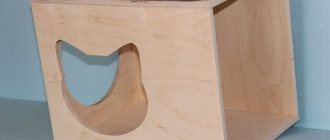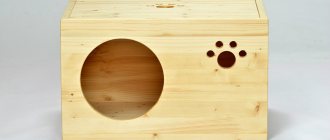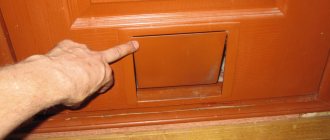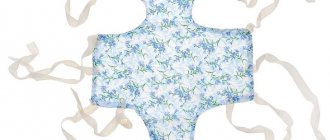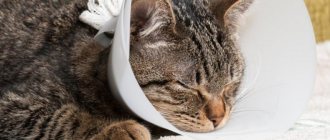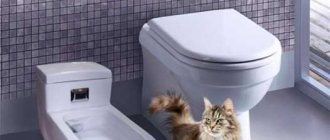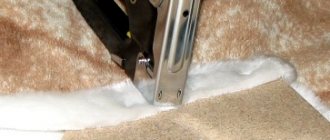Postoperative blanket for a cat
A cat blanket is a soft, elastic fabric that protects your pet's body. It differs in types, sizes, purposes. However, not everyone knows that you can not only purchase a blanket at a veterinary pharmacy or clinic, but also make it yourself! You will learn more about all the nuances and design features of the product in this article.
Types of blankets and their purpose
Pet stores offer a large selection of blankets for cats. They differ from each other not only in size, but also in the material of manufacture, cut and purpose. So, protective clothing for cats is divided into:
- Warm blankets for protection from the cold. Mainly used for short-haired breeds of cats and sphinxes. Owners put sleeveless vests on their pets when taking them for a walk.
- Blankets for the home, in order to protect the owners from the shedding of the animal. This is especially true for people sensitive to various allergens. In addition, many owners do not want to constantly clean the apartment from a large amount of wool. Sphynxes also wear light cotton blankets to protect their furniture from stains. The fact is that hairless cats have an unpleasant feature - high sweating. Therefore, light clothing or a sleeveless T-shirt copes well with discharge and heavy shedding of fur. Some models of home blankets are also necessary for caring for seriously ill pets. In cats with tumors of the mammary glands, in order to avoid scratching the affected area, the owners put a blanket on their four-legged friend for constant wearing. For ease of wearing and removal, the ties on the blanket are replaced with a zipper.
- Rain blankets. This type of clothing is used when walking in cloudy and “dirty” weather. Made from nylon and vinyl chloride. Such protective equipment is used only on the street.
- Postoperative blankets. They became an excellent replacement for Elizabethan collars. Previously, cats were given collars after surgery. But this device is not entirely convenient. The pet cannot eat normally and move around the house with a collar, and as a result, recovery takes longer. Postoperative blankets have become the salvation of all domestic cats. After the operation, the animal feels good in protective clothing, recovers faster and can move freely around the apartment.
Using the fixture
The doctor puts a bandage on the cat immediately after sterilization, while the animal is under anesthesia. Before tying a protective blanket, press a sterile napkin soaked in an antiseptic to the wound. The blanket not only covers the damaged area of the skin, but also limits the animal’s movements. This is necessary so that the active scratch does not jump, otherwise the seams will come apart. The surgical incision is inspected and processed every other day, untying some of the tapes on the back and at the hind leg. If liquid appears on the surface of the fabric, the bandage is changed immediately.
After the surgeon removes the suture threads, the blanket is put back on the pet to protect the surface of the wound. But now the sanitary bandage is worn for 3–5 days. If the healing of the skin area is complete, the safety gown is finally removed.
How to fix it correctly
A blanket is laid out on the table and a cat is placed on top. If your mustachioed beast is impatient, ask another person to gently hold her. Talk kindly and calm the animal. Ribbons of the first pair (at the neck) are tied together above the withers, and numbers 2 and 3 are crossed above the beginning of the back and secured in one knot. The ribbons at the hind legs are connected on opposite sides: the sixth on the right and the seventh on the left. Tied together. The remaining two pairs of ribbons (4 and 5) are tied on the cat’s back. Veterinarians recommend making the ends of 7, 6 and 5 rows of ribbons in one knot to reduce the inconvenience of wearing a blanket for the animal.
The blanket should not be tied too tightly to prevent swelling of the pet’s skin.
The bandage should not be tight or too loose. It is considered optimal if a finger fits freely under the bandage. When an animal cannot walk in a blanket and falls, the fastening above the ridge is too rigid and should be loosened. Make sure that the cat does not accidentally damage the ribbons.
How long can you wear it without taking it off?
If the wound is dry, there is no swelling or redness, then after 8–10 days the bandage is removed. But at the same time, the cat cannot be left alone. Watch how she behaves. If he begins to intensively lick the wound or injure the sore area, then he will have to put on the blanket again and show the animal to the doctor. The cause of restless behavior is probably hidden inflammation.
Video: a cat walks around the house with a large bandage tied on its back
Features of using the bandage
For a cat, an oval cutout is made on the belly under the tail using a purchased or homemade blanket. Otherwise, you will have to untie some of the ribbons from the back and turn back the edge so that the animal can go to the toilet. This is inconvenient for both the owner and the sick pet.
Our mustachioed friends have different views on being forced to wear a blanket. Some show hatred with their entire appearance and persistently try to remove it by biting the ribbons with their teeth. Others are cunning and pretend that the protective bandage does not bother them at all. The reason for this behavior is simple - the cat is patiently waiting for the ribbons on its neck to loosen. And one morning you find your pet without a bandage, which was left lying somewhere in the corner of the room. It turns out that the cat has already pulled out all the threads from the wound. It is good if the suture is almost healed, i.e. there is no bleeding or fluid discharge. In some cases, you have to take your unruly pet to the surgeon again. Then the treatment is delayed for months, and a scar remains at the site of the incision.
How to choose the right blanket for a cat?
If your cat is undergoing surgery, you should choose a blanket before surgery. Your pet will quickly get used to the protective bandage and will feel much calmer in the postoperative period. Buy two sets at once so that you can replace the blanket if it gets dirty.
Pet stores offer several types of blankets, they differ in material and size.
The material used to make protective clothing is non-woven fabric. It is dense, and if you trim it, it does not crumble, it perfectly absorbs various secretions and liquid, thereby leaving the damaged area dry. Doesn't stretch after several washes.
When choosing a protective postoperative bandage for a cat, give preference to natural fabrics; they provide air flow to the affected area.
To choose the right size, you need to weigh your pet and measure the circumference of the sternum. A correctly chosen bandage leaves a small part of the back open (up to 9 cm). The volume is regulated by ties. Standard models of blankets for cats up to 5 kg start with a size of 38 cm (body length) and a chest circumference of 30 cm. For pets over 5 kg, bandages measuring 42x35 cm are suitable.
The blankets also have some differences in the method of fixation. They mainly sell bandages with ties that are fixed on the animal’s back. Less popular are models with Velcro instead of ties. Such models are suitable in cases of temporary wearing of blankets, for example, after sterilization or castration. Thick blankets with a zipper are considered the most comfortable. They are easy to take off and put on, they do not come unfastened and do not hinder the pet’s movement. But compared to regular ties, zippered jockstraps are a little more expensive.
Medical bandage for pet
To close a wound on the body of a domestic cat, ordinary bandaging is not enough. Feeling pain, the animal pulls off the bandage and chews out the surgical threads, risking infection in the suture. Therefore, veterinarians advise putting a sterile blanket on your pet. It is a blanket with holes for the paws and is tied at the back with ribbons. The device covers the lower part of the cat's body from the neck to the tail.
The main property of the product is to prevent pathogenic microflora from entering the surgical incision . Additionally protects the surface of the wound from sunlight and mechanical damage. When treating a sore spot with medications, the coverlet is partially untied without completely removing it.
Other uses:
- protection of the animal in the treatment of purulent ulcers and eczema;
- fixation of drainage;
- ensuring safety during treatment with acaricides;
- isolation of the tumor in the chest area;
- preventing contamination of animal care items.
The cost of a regular sanitary dressing is quite affordable. In November 2022, it was 75–120 rubles. This is a simple model with ribbons. If desired, the owner can purchase another version of factory tailoring with a pattern and fasteners with buttons, but in this case the price of the product will be from 1,700 rubles. a piece.
DIY blanket
If you want to sew a blanket for your pet yourself, you won’t have any difficulties. It’s easy to sew, and you can always find detailed diagrams and patterns on the Internet. It is best to select fabric for the bandage from your old things. The cat, feeling a familiar smell from the fabric, will feel much more confident and calm.
To make a postoperative bandage you will need:
- chintz or calico;
- ribbons;
- tools for work: pins, needles, threads, scissors, pencils and a ruler.
The dimensions of the pet are taken with a tailor's centimeter. Measurements needed to model the pattern:
- chest girth;
- length from withers to beginning of tail;
- peritoneal girth;
- the distance between the front and hind legs.
When cutting out parts, do not forget about an allowance of 0.5 cm. Before you start sewing, if you bought new fabric, be sure to wash it so that it shrinks.
Having cut out the parts, sew them together, machine the edges, and sew on fixing ropes. If desired, replace the rope with a zipper.
When preparing for surgery, prepare several blankets for each shift in advance to ensure your cat feels comfortable.
Caring for the bandage
The bandage needs to be changed when it gets dirty or wet (for example, after going to the toilet). It is recommended to treat a fresh (washed) product on the inside with a steam generator.
You need to have two or even three blankets available in order to promptly replace a dirty bandage. If it gets wet or gets infected, the seam may become inflamed!
The blanket protects the postoperative suture from dust, dirt, bacteria and prevents inflammation, thereby reducing the duration of the rehabilitation period by several times. But you need to choose a quality product, since otherwise wearing the device can even cause harm.
Options from improvised means
You can make a blanket from scrap materials, such as tights and socks.
A pantyhose bandage must be made from tights with good density. You can also use trouser legs and sleeves from already unnecessary clothes. Holes for the paws are made in such blanks. After use, such products do not need to be washed, but simply thrown away.
Sock blankets are suitable for kittens and teenage animals, since only they can fit into products of this size. Only a new, never used sock is suitable for production. Slots are made in it for the paws. The hole from the heel should be in the pet's groin. A cord can be used as a tie. This version of the bandage is not very reliable, since the animal can easily take it off.
Using tights, socks and other clothing to make blankets is a simple solution, but the material itself is not very suitable for performing the tasks assigned to the product. Therefore, it is better to sew a bandage from scratch from a more suitable material.
Taking measurements for a pattern
To ensure that the cat bandage is practical to use and does not constantly fall off your four-legged friend, you need to correctly determine its size. Before sewing a blanket, you must first take measurements.
To develop your own pattern you will need the following information:
- chest volume;
- body length excluding tail;
- distance between paws.
Some felinologists also recommend taking into account the coverage of the limbs themselves in order to calculate the optimal length of the ties, but this can be done without this data. When you have completed all the measurements, they should be transferred to paper. In this case, you need to take a small supply, which will be used for cutting. As for the type of seam, there is no fundamental difference. You can use any one you are comfortable with.
Dressing up
The functionality and effectiveness of using a bandage for a cat during its postoperative period after sterilization depends not only on the correctness of its cut and manufacture. After surgery, the bandage must be tied correctly and carefully. If the fasteners or ties of the bandage are pulled too tightly, it will be too tight, and this will have a bad effect on the healing processes of stitches and wounds. A very loose tie is also ineffective; it will move, rubbing the seam on the animal, or the cat will pull it off altogether, and also damage the seams.
When dressing correctly, you need to unfold the bandage, straightening all the ties. Then the cat carefully lies down on it and the ties are secured in front near the head and front paws. After this, the back ties are tied in pairs above the paws and they are bandaged in the pelvic area. With different cuts of blankets, there may be a different order of dressing. The main thing after putting on the bandage is to make sure it is properly fixed. To do this, you need to let the cat move around the apartment. If she feels comfortable, moves around freely and does not try to tear off the bandage, then he is wearing it correctly.
However, most cats feel uncomfortable wearing a bandage. They try to get rid of it, gnaw and tear it with their teeth and claws. Therefore, a properly selected fabric for a bandage, especially its upper part, should be relatively durable. If the cat nevertheless takes off the blanket, then first of all you need to inspect the seam and, if necessary, contact a veterinarian. If everything is fine with the seam, you need to carefully put the bandage back on so that it fits tighter.
Be more kind and gentle to your pets during this difficult period for them, pay them more attention and then they will forget about the bandage.
Medicines: analgesics, suture antiseptics, antibiotics, vitamins
Analgesics will need to be given for the first 2 days. The fact that the postoperative wound hurts is indicated by a change in the animal’s behavior. The cat shows aggression, meows, and refuses to move.
Analgesics will be required for the first 2 days.
Doctors recommend using painkillers:
- Ketoprofen (1% solution). The injection is given subcutaneously or intramuscularly once a day. The dose is calculated at 0.2 ml per kg of weight. Inject no more than 4 times.
- Tolfedine (tablets). Given with food. Dosage: 4 mg per kg.
- Meloxicam (suspension). On the first day, give 0.1 mg/kg, and in subsequent days, reduce the dose by half and give 0.05 mg/kg.
To treat sutures, veterinarians advise using:
- chlorhexidine 0.05%;
- Dioxidin 0.5%;
- Chemi spray;
- Vetericin spray.
During the recovery period after sterilization, antibacterial drugs are not prescribed. Antibiotics may be required if postoperative complications occur and an inflammatory process is detected.
For treatment use:
- Amoxicillin 15%. 1 ml/kg once a day for 5 days subcutaneously or intramuscularly.
- Sinulox. 0.5 ml/kg intramuscularly for 3-5 days.
Vitamins and restoratives are given only to old or weakened individuals. Gamavit is prescribed at 0.05 ml/kg for the first 3 days, and then the dose is increased to 0.1 mg/kg and given for 2 weeks.
Purpose of the product
A blanket is placed over your pet's belly to protect the belly after surgery. Thanks to this cover, the surgical site is not affected by pathogenic microflora, and the animal will not be able to scratch and lick the wound. So the cat reflexively tries to speed up the healing process, but in reality this only leads to irritation. Along with her saliva, germs and viruses can enter the wound.
The product is tied tightly. It pulls the edges of the wound together, making regeneration faster. The body will have to spend less energy on tissue restoration.
A correctly applied blanket prevents the abdominal muscles from weakening and stretching . Therefore, a sterilized cat’s belly will not sag.
Dress for the sphinx
Using a simple pattern, you can make a beautiful dress for your hairless Sphynx cat. The most remarkable thing is that a dress of this kind can be made from just two pieces. First of all, the main part is made, and then the sundress, which is sewn to the base.
For your information! All this takes very little time, but looks very attractive. Do-it-yourself clothes for the sphinx, the patterns of which are presented in the picture below, can be made in a matter of hours.
Knitted suit on a Canadian cat
Selection rules
Choosing a blanket for a cat, for example, after castration or sterilization, must be done very carefully and carefully. The following important criteria should be taken into account.
- Material. Choose postoperative blankets that are made from environmentally friendly and safe materials. This thing must be breathable. It is advisable to buy blankets that easily absorb liquid so that the animal’s wound always remains dry and does not get wet.
- Retainers. Monitor the quality of the fixing parts. Most often, blankets are made with zippers or Velcro fasteners, as well as simple ties.
- Size. You should choose blankets whose size matches the size of the pet itself. It is advisable to make all necessary measurements in advance. You should find out the volume of the cat's chest, as well as the distance from the base of the shoulders to the tail. Typically, all dimensional parameters of blankets are indicated on the packaging.
- Color. In this case, you need to pay attention to color not because of its beauty, but because of its practicality. For example, on light-colored materials it will be easier to notice any discharge coming from the wound. In addition, you can easily see that the product is dirty and needs to be washed.
- Workmanship. The blanket must be made correctly. It should not slip or slide off the animal’s body. If this thing is not made as it should be, then it will be of no use, and it will be difficult to put on. There should be no protruding or fraying threads on the material.
- Package. It is very important to pay due attention to the branded packaging in which the blanket is sold. This is an item that will be in contact with the animal's body and the surgical suture, so it must be sealed very well.
It is advisable to choose options that are sold in completely transparent sealed packages. In this case, it will be much easier to evaluate all the necessary parameters inherent in the thing.
If this is not a medical blanket, but a home blanket or raincoat, then the choice should be given to products made from high-quality and hypoallergenic materials. If a thing is warm, then it should be soft and cozy. It can be fabric with a large pile or natural wool.
